While less than 5 percent of luxury fashion sales stem directly from ecommerce, half of total sales are influenced by a consumer’s digital interaction, according to a new report from L2.
Following three years at the top of L2’s digital leaderboard, Burberry has lost its rank to Gucci and Coach, since its omnichannel efforts could not make up for an outdated Web site infrastructure. Brands need to ensure that they are maintaining their digital flagships as they expand their digital presence.
"A brand site is crucial to the research online, purchase offline (ROPO) trend we continue to see and is core to the online experience a consumer has with the brand," said Leslie Elder, research lead, L2. "Historically, Burberry has done this quite well, but more recently as with their mobile site relaunch, they're demonstrating limited ability to offer customers a truly channel-agnostic experience.
"Keeping a brand site relevant and truly tied in with the brick and mortar side of a brand is a significant investment into the online platform, supply chain systems and even store associate training," she said. "As digital continues to evolve rapidly after a period of expensive brick and mortar expansion, the brands that will be most successful are those that best combine their online and offline channel efforts."
L2’s Digital IQ Index: Fashion report attempts to assign a digital IQ to 90 brands, looking at the brand’s site and ecommerce, digital marketing, mobile and social media.
Digital champions
Gucci soared above other luxury brands with an appealing mobile site, an ecommerce site that shares inventory in-stores and live help from a personal shopper on the ecommerce site. Gucci also advertises in prominent publications, and runs extended social campaigns, including one for the launch of its Jackie bag.

Gucci's The Jackie Bag campaign featuring Kate Moss
Other brands deemed “geniuses,” scoring more than 140 points, were Tory Burch and Ralph Lauren, which effectively uses email to introduce aspects of its brand to consumers and which has experimented with fashion tech, including its Ricky handbag with an LED light (see story). Burberry is now sitting just below genius at 137 points in the “gifted category,” applauded for its use of Twitter’s buy function and its expansion to Tmall.
Besides the top 10, there was a lot of movement within the rankings, as more brands up their digital game and competition heats up at the top.
Jimmy Choo was the “biggest winner,” jumping up 38 percent to achieve a gifted score, largely due to its new site (see story). Lanvin moved down 37 percent, mostly credited to its sole focus on its anniversary campaign and microsite, at the detriment of other initiatives (see story).

Jimmy Choo Web site after redesign
As a group, Kering outperformed LVMH, attributed by the report to its partnership with ecommerce platform Yoox. The Kering sites have a 30 percent higher performance rating.
Compared to other sectors, fashion brands are still sport low adoption rates for ecommerce features such as live chat, inventory listings and user reviews. While some brands have established a click-and-collect service, it often does not tie into existing store inventory, instead relying on local distribution centers to deliver the merchandise to the store, which takes more time.
Also contributing to an omnichannel experience is getting consumers to shop for an item online after viewing it in-store. Convincing consumers to take this step is easier if free shipping is offered.
Fifty percent of brands have some kind of free shipping offer, but brands require an average minimum purchase of about $200 to get free shipping.
One way to get consumers to engage further with a brand online is by offering some form of customization, an opportunity only 15 percent of brands studied currently enable. A limited amount allow consumers to save or share their particular choices.
Stuart Weitzman is one example of a brand running a customization program that lets consumers interact with their design before, with its SW x You campaigns (see story).
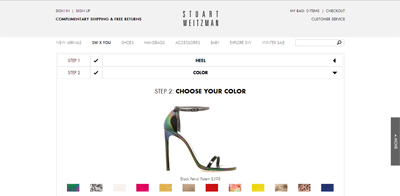
SW x You
The vast majority of brands studied, 98 percent, sell through third party distribution. The Net-A-Porter group now distributes 53 percent of fashion brands in the study. Net-A-Porter also runs Givenchy's sole ecommerce platforms, two mobile apps for its men's and women's collections.
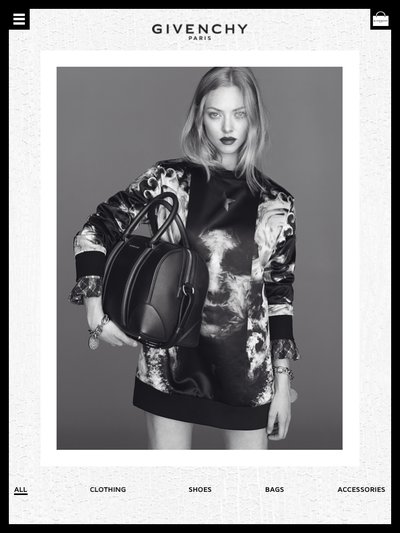
Givenchy app
Brands are also investing in mobile, with a third having a mobile app. Most of these have almost no reviews, which make them hidden within the Apple App Store, forcing them to rely on social media to help consumers find them.
Based on user response, some of the top apps released in 2014 were Hermès’ Tie Break, Michael Kors’ 360, the Givenchy Men store and Fendi’s myBaguette.

Screenshot of Hermès’ Tie Break
Drawing traffic
According to a report by PM Digital, search engines create 49 percent of the traffic to luxury sites, compared to the general apparel market’s 38 percent. Google is the largest referrer by far (see story).
In addition to paid search and SEO, brands have been actively advertising on large publishers’ Web sites. The most common publisher with the most advertisers was Style.com, which secured ads from 22 brands.
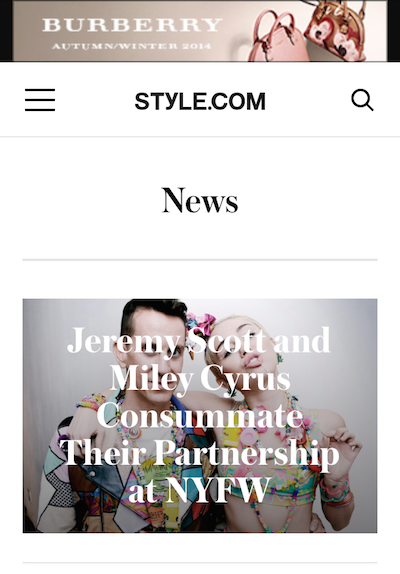
Burberry ad on Style.com
Part of the reason why it was ranked number one, Gucci lead in number of creatives used and impressions, which were 6.9 times over the study average.
Brands also continue to use email marketing, with 99 percent offering the option for a newsletter sign-up. Email boasts a higher conversion rate than social media or ads, so getting consumers on-board, either with incentives or a pop-up on the Web site, is key.
While it is commonly understood that luxury fashion brands do not discount as much as mass brands, the report found that the most frequently used subject line phase was “% off,” followed by “sale.”
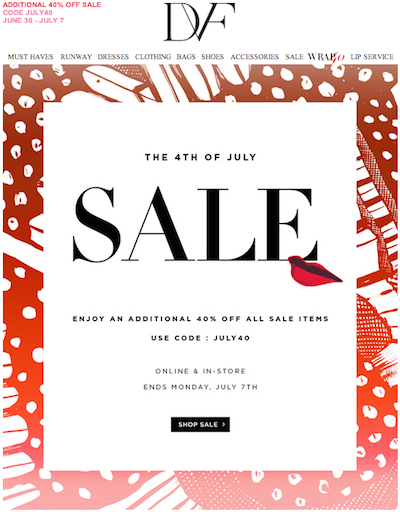
DVF email
Social outreach
While some brands still eschew social media, such as Céline, most are continuing to grow their presence on social media, particularly on Instagram. While only 88 percent of brands studied had an account in 2013, the number has grown to 97 percent in this year’s report.
In April, Italian menswear label Brioni expanded its social media presence beyond a solitary Twitter profile with a new Instagram account.
Brioni timed its Instagram launch to Salone del Mobile, for which the brand had a window display, in order to have compelling visual content to gather followers. Even though Instagram is an important platform for fashion brands, Brioni may want to consider spreading out further, since different social media platforms have different audiences (see story).
Facebook and YouTube still offer opportunities for engagement, but Facebook’s model has changed, forcing brands to pay for sponsored posts to gain visibility. Both Chanel, Louis Vuitton and Dior are within the top four in both post interactions on Facebook, YouTube subscribers and YouTube channel video views.
Going forward into 2015, brands are expected to put even more investment into digital.
"When looking at the data, particularly on site features and omnichannel investments, it's easy to see how far behind fashion is compared to specialty retail and department stores," Ms. Elder said. "However, when you take a look at the fashion group, the width of the divide between genius/gifted and challenging/feeble brands is particularly surprising.
"There are brands that have made digital a priority and are quickly putting up barriers to entry, with competition becoming very close at the top," she said. "On the other hand, there are brands that don't invest in digital at all, despite a rapidly changing luxury consumer.
"We would expect to see continued rapid investment into digital for many fashion brands, with those in the bottom spending to catch-up. Given the large gap with other industries, we would expect a more concerted investment in omnichannel capabilities.
"Genius and gifted brand investments should start to be defined more by offensive moves into the digital space as they finish playing catch-up and see both tech and sportswear brands moving rapidly to capture a piece of the fashion space."
Final Take
Sarah Jones, editorial assistant on Luxury Daily, New York
{"ct":"+Z9vylefNqeMlNK9dmZ1V0wXma2OWRKg+MNuVE9LBuNkrajLUo3Sgd6fVE\/rmQ8JBz0Mppimm0fRpJbzzS5aF6EKeJaYYxUhXvTrTyKmE6o5wHPzY7giZUMOqm7m8p5+7zoXFPblDaowMboYTD\/e7T5lEeGHqIxYKCFJOlvnCJhk\/xlHqV\/3XYafo8oY\/OE8R4dIRgdB4Z45OtndzOmzp4SIT8enjwmLBTlmnexuco+d9zqp37exyzVf+GLUOEGkQpChsDtAHpgBa\/L4YZJDuaOxKdt0TMh7+z3FLEKrntMIijlRIrs7nXmAFpRzDK1ehvLRTPC6BCStb8Xr0pkiNJZwD8Pj3XotVFDW+UtlEEgJrl8Uam91nW0iJTbFmKv4TdJj5XpYMEr5h1JE4DT3UgusClt3sIszceiRyy4qy8FKreKCS0FiC4dMzO5Cd0qIEaKe4gV4r+XtaSafZS6\/Esz9lH5lFLoHwPSvLQDlfpceTcTiEzwXC81bMg9NNRsF4nIoAr65NAnikpoOxyPrEFMaGGGXZyaXRk0W8obEDzGUs8N2oRFQxmT5fe8I40Ldzbr0IIJQ\/b4+4yoz1uJPbmuZjB6tYjGnoye3i8+jYzZByGlcCQOSQd3OVLdsUGhXa9WcRN2GG\/C0tGkOaYp9IsnoQSPHmeTKEOCgs4qTgM8KTVm5z570PqoHJYtRwFz2OypkChoc+mv3+NG\/9X8cA1MdenmBLi4xmK\/9uky1+sU96hmVa\/ecOYEWMuFgSBoli7lPzU5izwBBL\/w4KP1RCPd7wx1cjdIxdsOZbxaZxq2VfaGKRryELA7hSx5bsCFiOX1s\/xlvg\/OvZFUVJbGDznug1SFvQf+QMgX0kbXYo5agZCz+zB0rZ1BvcFUkK5PzR95\/cpX3pXTMsHr4ht4KUSwNxJRq9TIYi+pA7qp2QbJtU7BoWbDL2RD0HYY0njMlToKhrf+2zTO6y7+YHdrGDIcT7avI7cLC+htOyxnLyClX0BuQebwxXyC2ZTAgqqxMixXUhk9jl\/u59nqQ7j9bDYoFkgufrwGl6tHu5YVxzghe\/Ltb1ccANx6tFUUTbEgOsWsUSSBF8pjBKoYwDo2jdkj7NKibpOTNER9GznoKnts1fWbxkicx6bKfQItyzr4mQzRBSKEgR8aCWdzX7X2gbufsoQjNJ33im6wXTWRBYfus0RDUZyWBNL\/Xktt7R9G93BDzJHN17XZ8pTr+olvEePiy++T5QfEPSxcjOZyI7ypm3x1xGtF39HgvK8Kod2aCBou2WygK7mnUfUUOIAh9qFVoQfu\/+KPqsfX08sa\/gQSmxv7aO2ttgn732GwdWTwJ+9HLxekMGNXfRW2PLjkc+FwDloGXkCm8mtTbdCWbsec8nxmyAh5vG2XkI6VY4fwEtDKFWWqviHGzWUdTopWQ+hUnUzk36icM\/HGT7rcIv5CeLmPw1dwmJUU1WHLBxnhf2UN3QrrF2efTmt91ObNJmSNIOeZXDfNrXCnUB30E+EENBXDZmgYvEXAkHwtLjUDPVwIq3zHcV+fF\/DHgLIzB2nkkAuB53pxn607htBN5zktPEWIRwhO45O00A8tF64KVF6DsXKV4WNEXFBSHbRnUc7IsDRTFIWXSNWexm1E5e3rpPKNDU7xFFkz+95xgM9s7AMc0u\/arvPV8I7OJDzyllFhvOct1Ei\/huXmjGO6SxaLyPcL9FOHiJWC3Ri5BrX1fcDQoQdi4IfuZg1TQvD0yTO\/nqGy5Ne1PT2C2ATwPdgDchXJzt+\/bffr99WLq63KtkDZ39+N1ltRH6Uyl6s47zRGUHDkfVnGS2yjQFGCD2wdiWITbJ+K2+RDOpv5a3rTM0UCrfVA0vH0nSWz3P6TRk43TjRm7iDJ9a6DZnw83pvwtcJoStrQhkRk+s5wr56RV0WGFjp9fLgzxsrt6zVRI0nsorBLVugCwKZO27yUtil2wn6tX8vuNmAvSSUK0eWp7GAy+dB\/1Ll6hwzTOAL8pMVRYSKZJc4wvuSYKQb2IoH2mDjqZxnHDfYPEpoIG1pefTcMvxIrjOPXdBOdr9osLzpr2WcY9F3yH5TdLv3eEp1HHTn3P33nkfg2G00L7H0hK+s04EmlpQLoZ8Y7juhVndS16LcsOmwRPs4DoBREwHq9\/V\/tnIxFSawjnsOB4I9dX+Ovq5KmvSRpdiVZseqYpuZ7ISBWlhiie0TqifpY+sabg05y+QFm\/w53Fh57beVA0TN25KIqq5aGHAAuNnW3whJ+yzj\/Yn9\/7YYtRy7CTuOyUUFPR2N64\/R+kfTG7NZKUtZg32n1s2gfeSylFSrbVNQSgruDu3fqsyDR+eM1Y4Nz0hFSX6Q+HWljrY3Jx9T6e86V3APwO75y77MnEhCpr+KTrCNiIfQ6c53XmVWjSmpBeZFciBpC3EHM73zlxADhra3+xkiEcD1zEXXF7t9dLMaxBzy2Rj0408RQ1Rh1R32dgpLAuvcY6q7MqxPjx2GwXkfw7RTulz7kfF9LivRWbGSyurRqDXhtbhkwCXTmfKI+TL2zH5nyMa+yNQLOYjpBhMgPZwIlSLGyNMGp5WsRG7+JvSBbtzQpptoWtMCUh8bK3wkUInyMxUiV43iDm5oZfqoo5+8hEaChUVjw3dubI+ZW\/Xrtxvo4vvR4qIDapBSDR0OBN5XByhgQgXUGeawPf09Jo0HidyqMdCCa\/x7k1ZrHS8zSBZ2E8uKHtUq1E\/ffWk5D9+MBBbyuzVfdVy9+1hvwVx+wV7pqPBsq2OeOZO4Xp2j6Ckqy2q3cFYA0yOJBiCXOMnv+\/67ClYf\/bQG+IUeZINWEmCRI+FYI1tc2P11nVJeuOt69u8OFplzat+H1m\/jMstpgH9wHCD\/\/5kIC\/MW94PODhfIb4ATczJu\/F83C4UeLJOOWcBSNy+\/3erdUb8msKVrGL3Yr+Ofm0\/0b4KZ61x7k8qrAmRgUlWkulhoTxmViHwxQlCPBIvqSNamt02uemQ4gIf0Li7mIReOHaiUZOEFlokwwCuASJcvwRF6MyTdcaPymJMH5q1kW7KEaTb\/OiMFFyNdbnI\/ucY6Nph+5y3pCEBVLUTPkuHCvh2UukcFrCoiQ2NuALjRc6V2uhaWCII\/VQG\/m80Q1XuGhnrUuoHaA+OIvyRy\/wdihLh1iN5E8+yj75kN+CUw70nnutVbRzni6IngER6MWuyDIHXWRVuydKiZ4v+61zQpwuxcsd\/KDvUlPmUjcGJciZxPTL\/Eyt9IHk0y\/3HLHPbzVMfe5x3zXKrdXEd6ljw+I64goikN7I8mWj\/tKlCFLJ4jgbTi2utk+CUIOtA1TJOuEMgTddQCValCECwuY4b2JNB+S+O\/c9pVcVlAatGpGi4JzAsTg9NbWsnIo05QD6nQtedN5n6Z0g2ZMQFY\/CGnJClDrJJd3ImCroH1DBnHYCxBAivYc0I1D6kvLzBX7UfoVuFP+q7NcrIqk5GfOqb\/yunI3YqGDhSnj+QmOt7JNm8YurdnW+tO+TvvTf1G+jO9OfEadSmvRGCNSjkPtTO\/CSxuPpeoC5fMKAThA13IQrkptcpnSTLYttBPnh1WlAy8BqG0vRt7z+p9Pzwe+PzYiyj+BWqF8E3dv8cb7MfJf8iNRZw\/0XrDmkN1kMXxKP7hBq\/5MrMIyzzSS8avQa\/hNwRmEnAAvTIw8WEZG\/SixqiEAfDepy5l9TrIeul3RtFi5Rq\/vUKfzkxX5Mz8pxyrSjYoO1K48qRfy8UStdfv5wOdUgEt15I3rcYRuOnu+q+Vd8cQZFPyJQ\/fj0eIuxaoQsAKhz4M4b8cO4bAu6paTjUY3FdqbAxAiNoguhev5fiwDQYptNcNk6UObmcQZdD6UTDIxiTZFFAqEpy4r3P0UMYzJG\/qwIVMVei+tk9gQmBarwMuYykjEZ5dfXYXitL52kB\/3MTdi73yceBl2QahvI2H+YphTMKZMZJRG3XatCQELv9pfsVBdZC6dH9UpzoyitpfyJc\/Rc25Bt+z1hz3CJrvSiN+etam0BSo20Zc9J7gj2+MHvoqSYvk4P95KKza45btWbb6KTij2+QNXU0P7hWrRVEEIbYHtVNBrHs7OZ42+DPzPekBHxVqXSgLMb6W\/c7uLvbB8+jvYnICa8EoSaXI1fllkznpm0RZm4QYPPToPtRjw8pOxKo9WNiyN03+clnrFZWlClxPhZ\/iIMLZsDSM8uJqaadN5K4WlKCR8z18s57LeyXRNWMORikJG+YSC9s7FHi8P7ovHgyc3z8FASjtfTAZb0xfGHSzKVzmmLVmUgFt9jpe\/S9BGxlwjmOUECQQxDH8rie4EAbl9cZs7iuOKK3hp0cCtIQuLPQhoLltQzyqLsbsHXFt1QPqSPPHTIfAJj9hbxssDqiSQ5IapvWlXZ1Mi5IfzSs\/KLGZqQ87hN4n6RQA8VtK8K3GL3Vu2rqRarJUl1ns3lecXtGvAFIfmPELAI89APxgsN\/GZ6w7zR0amAkythdj6LPVbBPRDztoY1HTQOW5tGk7NGl99WSpUZ02QAelftHxnp8ctfqZJb+XFNajWixphdeifcpQMR7hz7l\/ZdzbUsA4OWwSJE3x\/s3JBbHAOAVJq1FCgZ13xyUvwMNf4gAxOMsMpPl48RoxHFKTRQjSJG8ngQaH1Tgt1jRuNwQ0MK14E+nOqzJDHG6EuN7LtbP10+MlJPx7w9P0L95YRtDTgAmupNhLpIQaz5gdYe108aipgV80GyiTTTm0fd9LdOhSWRvaEOMH9eev6nARamWdGQfSTDGFTbVIsoV6N6NTsOpiWbYTtqayP8dyxyJnyGhjWREFijfVve+UwcuMen6SMFaIyNUPPUrIh3t8f\/OEA\/5K6IYTP0Rrs0bKshz1inH1A61p4oivbnbiIrIqkFwx3gqxcdznoxYCJpJ7CZrWDZZsn1rcxqaIPQ6WXLKuKX7SZVpLIa7tk\/3FYwwE8EFTNMSRvCCxXjGDQZ1NH0Fk7djMabNi2nr6T4KtMFt1iia4uuPn5qcD0S0lyTPMKVGylNjLQ\/RRcYfw4\/WoW8Wu0mL1on1cmtw5cIvHDxvpsvfW5\/Gljt6Sf8e5XCwHcx6Pr\/CHIoHFUHHHdBFN79FxqV8+RGxNJBlECuWQmecaopqwycmkDK\/96y4rVtpkanx68IxXxMIEmFYru1EVSBxfJg4Au1f0RTXZvkKzmip+DwUY5LmXN7gVKXSYhYMu2UeeaShx3BRcFozvatNDmRKb96RCRLwt4ShWD9vEiGRenoP7Urw6Nocbogg\/GnK8GPPAD5WCadD82q90X0vlJVXQxkeyRSiEBszP6wU1+87BnAEi8ng\/fiu+KM+0kgFWVwasxL77DBlbaSeo6t5aJT7QcxgU43IMIRMUPof2mWfGX1eQvfw0IZkr5f9uEydphfM1ylm\/wE67KunQxGxuol2P7B1enWazO2IsG7Pc4V3ciYFMi3VZmGKAG\/SvKMajI+pOGostEEDzaAXBGtpz1MuiQ4G0LOw75Xt9ZPnPJVP8qyVleRMtLmu8VCDjosXXYjdLCYvxEUHyjBB+xqHOn2g0Pa8+i97yWkABt3py+r4PK4gcSTuSfINz1DgXqsaAbOnwVDlO4zATc3aMPEdg4Y88akJY4EFcCwqCfvYPytdiCu8zkRn+UV0zFuNS7swQKKRDtGPOPXh66N5I5XnmBXzG6cM1yBNg+n+KRfcwzc7HanQ0\/QDAc1O\/nVT7Xip6eQlzXjIbV1Ael1ovCunJRkKJN2E5tzI43w71mLAVv8w7wT8dVtkntK6Knumydc1lLAH\/kCsjfGp9g2MOEoAOO7i1epTvIzj6KrSTvZ00jddhS12KMxgwaf\/nMKyIVQ+gE+peROsl+XRAPA2FjZCeqmYFEX5kwJxJnSuY3XbO2D3fV02xsonfA6rm4cxTa20TDkgpnQRD2\/WicSBTspxIxkpv8SV5\/21YsaAi\/ROOuy1uvMzBwHpOwrFlU1XuOqKPI9q4GSE0IdSRRA262p2UWRM6+7mtUYIKQP69xDK6MOf57ck8SFb9yjhxDtCdh3DZu8\/c1naV+ZigS6mY1AcIFfDI4mmSkmvwb4Fr\/eSBjMDrGdNihv6Zjnvn7jnQOeQIjFl1WgATib6I24uty5xS+T\/kFmNSHOAgv+eXj9VMOkTLjXeR6BkVSkjDuWn4OLlkvoySzs5e5CcF7JVmfV+orVIx19rRSusUj4C3n4aMUU3OG5cnWh94DyB8ir9jXjrXpwSbt4PrZIGWBBqqcOW4\/3o4a6zfUYkDlXL8rZnb0\/Y8rC96x2Jx\/hZ8wMd1OLs3U36e7GmkaL0Jv0MGDqkyJqe5ux9U9h19+AfauIKKgGavrgNZZCkwQBiGrLFtNmmvxvlBvZTf91sY1gypkB5n273iwWCWCVEQ7xiKMOASb8D2MHTF5b8cpCGVKlXfqDhIYjNMFoohEP9Le27OHhF8maTw8Cx8khJylUhVVbs6AjRy2dxR7tT\/pRfD4ZpTt7CXmQ3WYrnGPZA962GUnGVsjZ6DOLJZvHEMoPoQMv8q3xnEXoDH+9l0rwMAiiBuoRPaapEgnQVVSrafLv\/XUJuUowP1neaDLdh7sDhYanorvaQ0V4NvhwWUB9QauRJRnpDX3xOQWAou3jc483mJx5YEbMT5hYwBBNAYy6Yqk4rVxzqgjH9hBH28q80a4WfOAGRUJeQy6ppJpNQzq\/Jq59a7L+Dl64hX1g8yLsMbw46A4ObCru5wCdc4c3TWnlG1se0mD7qbq6PzvfpgGCX4JLdiF1iqcL3DnNxCJUDnSkQeXCtovSC56vVmSvQuTzAhZos6QPKEw7QcDH04NG0eUAyzBzmXPn2y9plje3GoXFG39b5mQbf695nmSeTVwOA6LXtMyzScLG7RgY98Li2MELuje6uc5M1eAXnMCJV+zKcIVslKNMPiZ3Yr8BwrIjog+Ws6xi+FcbzzsCMmIsf5wAV64r+CwSVPSZYau3+NTQEiCA0I6WBWrd0O\/+Lw+SgVsHJ2pVohApE7d9fmjktdfoGO1c8pCsmCym9QvvMUrteIiXQSsvsAab1NI7KQOhG3ceJeTQdsz8jTR20udbWJppXO+1O\/M4O39Yjnz40TLEHIB81a7DdBQJMg7VCZYMp+75\/QIeZ3qyHS1hP0jIGA1n80zN3aVvWxOSSR3oUuoQUgT6NfbPnaS4h700zRiKdPRjYCXKfwSvLxrOwYxocO2suUO10QNaIHWTbMuFAoC3XnhCMqhT1XVtwopqgnPEeQaHkByQW1NfkCW2arKfwk8K4qzizhDn2ff7fWQESUUXk7CgDb+VCsuEkyex0aumEWfhaCIUQjHuS1hRGKJfld3O\/Y5KP0wV45AMqF0H3xl2jXbU+h8tNoU1J+7GUVNQ8wbbDcwTZ0sHVFyJzC50bNkiqrFufeT61ORSL3vV4tB\/bDSqAqCCN\/b4kJaLSIFhAqkLDRtfd6cGEQY8qoMsUmp3bJuIFz1zi8TUtAyiU+a7OqvjXgC4BpMLayy4C+QahOOETS181\/gdIC74NixzqjVvJH4+ov8nDgGdd9j7mARfpiHvroII8MJ+m5sbLvDfe7he6IYvtKR3JDBCfVhcVpgk\/MHVvi5VaWGPZhb1Kxhu8Sdapav4rn2kxwBz41SrFWub\/9vLArWuL1EtqRN1i1L6rxo4BOCgEp\/1mZicaFE5f5L4bvoYlvup4rVlxeDLhV2zeF05lAW3\/L9xqdD\/WY9JDKLkL1UslVe2JKcuyMGTm4uxRtohmbmfVVOnTPLKaGNaCfj+JuchH2DYdDEjwVCDUlyBhMIShxGsHqhrAscEqeFky0cjmjI6VFwAbQuSd8DfD6AvLYDB97klttjVaP2Oend\/P7WzfPQEYnNXmkw\/r7Bm4r64Jxuc4HuijDqdCRy1Y55XwK+BnUFfPHbxyB5kj6K0Fn6uz5tfp9ta0cK4Yj7ZornC1Bga+OVOZMtiFrHwbbTrLEIg1BJ\/WL7ORnAxebEDp5gzK\/ZHND5py7lEyXix9kU2FMF\/txv\/n33WuTGXznv2IB332gmYuKxbPDNJxJ61pycnULf30oS4sd+qbWHHtsln6vzJnNnW2YNgAqWakMfyhmPtSOLcmBeER7Puf\/9THtJsYpQwQi2VVrA9Pt4EctpjVHcXMploEtGgKfPTPDANA7bCBfUBzdEKyF7SZQO8yqigORppCooQ3VcoOpQnavj457u0rxgauMHFMbUg91uhYFq5f71HWk2Nm5B\/mD\/NalnuK8Vl5GQuNM3b9+g4O8f9AkkFjdyNNZchuvSkIiYmbN9n0S5diIsh8nROESW2NcoDkR6Hc0QHKlMIctePn2KcRrv4HbDyCeHg73wFmZQpHQsu+kk8ppqRnJhufF+sGG0dwzHMuTBMOL0RGv3NbmmqeS5Iy2oMPm8LiSJ9d+R5tUgSXgHSLzN0pZj+ubjQ0Cn0GQqcUpHQa9VJ1c\/JnPwenfa50mb3rBa0ZVxtu7yH8C\/GFVH6BL+DE6idbNPPd9Y3yc0xxcJjN5ZVaClWzy+UxgiAGSQ0P\/qHaJ\/5F\/MI3DORfiIIrQyozg2Qok6UhXyQkr4wDvLzb43o5hln1hicRsUSllh30y2NzXvl6j+lEBilF0ehzOgtYzYwgbeSFfFDPrHHJGbXo8g8LGBPW4\/e6Z9N8bCtbZtx\/N3Aa8Yt0WI0vxbvIQhm4Bb0eIFX5T\/MTrodwe2mIR+AIh67tUW8KBPBnBbwCPPaRpZ1nsYE2jXyU\/PtRxeZqFpHd63Rw3pPAHivBdsfamWAhhh2PhGOdAmkDAjb\/tJ8rsj+JPQn4b9wpCmnsBUnoDrBN7HmxtX8v+ynVvYDkQPWokpkbrxFfdAvGr9W\/iM7qBqWMNtxhz3zMx1Ir0PkQ1ngXj76dOlSoB+c2jHSv2Gg7aZHSopS865m3JfonS\/YtzDM1AeKGMIHO\/U+tc67EwFv1D2iNXvo8vlEL9RY7XsHVAoHXcauT0i4Xv3RHJEzN7eY44\/oj1LrCi0fW7\/y1dfjUeuQ+Jug2BXXrz0CPDQRdZvVV59YOWYw7CeuTUuqUwCSpRvtmPos9NznbKhwjtLlFurfOIzpOBZaNYL7+bo9Ya1iBbRG7Wa0PgPb8aOU0vIL0rsknwfHJreCn4NNwgrxuy12aE\/gGUOyRcD\/EZmKpBJV6fU3cIZOhnzCtQnOpEwR3EegosMsAjsJEQNXd+NBpAYOJup1WTuK3FF3d0gxgE8y125QrvV07CidzDuLFWieHe2c80dsxSJmRxAzE5FY6O3Z9ush4vYSzTBcbGPnaJOL8swSJwUbpWLThoY6ce9VM94ebKzdBpdrishypDyxsSOYb3Wo10jkcB218krZjYcKhV\/yKFARnOMCd5h8oxbXagazb03kj9dfpA8eiD2JAOG+VR+u1H9abac1joR3d1Nrsgv1IvKNBWoz3cqndS8bzUQf8Suz6XbO0MUjPCWoJjesery+1hrsntnxWdYRKYopwRnzbzNY+dG1fxZ94TipDJ9CYDrARUzhhNLT1N\/8\/7BcFNHLmbEDHqhMEyHRKuD\/XIHfnjarJa7ft4vaenioZGhDvP7UdQnjtBLq7BA7Gz+y6KcGnOPkHfT4yBGHlhz\/JpyIfePjpufN7111pkSwrU06mLwvM0GKIC0IzFjFbiM1lF31+\/bqWhXvdJcw5HCmi9Pcwf+KJWuMebWYJkJJKOk9D37e68NERMoWb3M1BdcavYQBkeNVr\/LxN8KyZ9ZXhmf2a7AYB2qkxSDv7R6aih3shGn1Fcb40sIB0jXriQG8y17nYXkFtzWpqhh4FdES0yBrr3VOAs0qRteyMCP7+symfmzMu5fukFZ+7C4a+1JHhbBk+CTuk7qHoKtvf7QSJXHrndI7Qb2SDcDSIhqEZMWMH01RPJskpjsxWLbVn6ia9vBeX8BA9Q6BbHrfvyfbcSSmMBacErxTc0xptrBdnaKKfYjcgz4k3ZbmglAUd+hcd6aBIIZRAOUW1Lp2EMKnAxzHUub4P2UorDu9zAGaBqJRU7XPNZrgHp2gSjki\/7HjvIe5ey0k0rUo2aWD5npHhFYxu7VhtUvoIRxy7y7NJ23nXs5Pv67hFZSxwOt1ekQjBinr9AKBqP8lR5uUTpzNn8v4Iyt3mwmdOW2Y4P57bfK+WXKjv+t4VEatvynBSqm3POWpKZatr7NjsGqBX+mGWc1qu1RDMRQUyQ\/GbDoLnPdzbWxjOlvqBS1d9\/Xh+C9oHUeKTNx7x1aGk4h7Lu39CGPHUH1yPGBvS4ET4W9BkAjsc6ErP8VJZ+qteJUZVUhFSH7X0F5RtMH\/sflPQ3h68mVI\/GZ85Bv4UjXFJfC2lCo4eVvWjm9v8yaJFk\/eajAzef+vN1rWW8b32jul2C83w9R7em0coQ7aw7Rd7eAZynfZYX0HrBVQ8W7QN2A2cjaEH6fhpw2iOSIqMkUtyhXk6FkRsYYxsNJVPstgkUcynpGh7wgl0T77CUqEIU5eUPuiR5nCLHoVxFjUrgF1Xok1SWsbcjH2ujnuTF9dM3k8GYGSTL4tUlLhE3+p7NBLY4zzRZlCmCDbOaBeYxqIg\/QytUHqsj1SybZTEhwVnzWv9MSQe64O3KAaMWMXltGd\/elUPTESmEhkYz0Ye3u+hrAtEK75BjR1x6fSvKRJbq7rTfMxOZ5NHYG8L6+aRBg1SeUNCFg3jrfemYrejOeGHjmWdCZjzdDKAtYkhaAyneeGZ6AZj409DCoWmgHJkd2+GD43HTsr+B9BI5tV43N7krGzMBSmgg4SrRfmcr+LDJldDiEbKYalV1XjOxZ508ZQw66Ejs84SJEEDdTUCDDYrqwkxgJUrvTvkUZ44ur2PGpQ7UrxFuQAVZS+bNYfiXOAxD9HvQ6lbThceYMqS1IBPdidnFR5plI9P+PT5lNKFv4yjchNOB7if6KFRtWUNwUIaIofkeANHyOjDjwb+Xmo\/M5bSyxQM\/+pdLhUS5M5mDxOFiyhDATyChDN2wX9Ueib0+imBb0p+zKbdyDGqSyzEEmZeRcRGgPhP9Y9QXXLprKS6Dd+ltl134RgCKsvLYoAmMHk8OpNksfPUpfkOkjOYvOZ\/dzzrPwCMOheNFQGWWrb1fWs2U4jxSFsY6PjvJwox9jYQV8tY9I6YoSQLx7X8CWl55z7ZqQKOsIvb+qFUxmnpzns9AlkHmWUj6QNw4iTi2cjYPAWnhjecPfT0+Q5zrcd1Xvaogvz3DkutIK88bmta2Yn\/Egb\/vSU1Rj+5mJXdkk0Sxq9Ee7i01eb\/a+2MUu9MPkKZL\/MW1L7sreqvj7F3uN8dgCWFqQ5iKeILwPxGJD3DbvSrC4fsTBGEHAbFIZgQeoP1\/L0MGrHV0dSWSYEb6hJ9fuZ52WIUbBLGq7m25zVcA0gKNvd4cs+IKyE+MQ7NEyHSYl3AsegJW8MjTdDg4JLwsLXnW1fHJ2XOF4vlHzBC082XKg0UT+YKUWIUP8oOs\/3ROcLzDrM5LsSlXTyIyOwFoP9Gut3ZlGKmSsbU0LdDrJGALoWLX9p160Ijxk4nC9yGCS0EMSYr8RaT26knIWrRS8xBk\/wk8Msc3ZiRExPMVM2Jwv\/JBValkxl6aIuSO4HGdW+cwNtnCCbsGeh5kntljGzFMJ8CqFIGygL\/lviSr7U4jmSnC0Xr+RY78AsW9awHJllLl6fpcab\/cduvB9ZlQcaErj0H1WYouwRKgcFHz4Z14CTHm2PYrbUMi28CvjRmSnhZ2OpfpVe0bkGVygnLa7ralpN1MBLBGI5wd5BJMve33ImCLNknLBgVVy\/h8SYVgqYJdkLNHqhlSQUqpHiP701Ck97mrURlakd6ckHkJSAIFeU2GR87dVtMBgn7yw+\/4j9yxYhNM26sSNquHbErDtyIKQuqYIpbYGvpvcNWbvBC7Yhoa8db4GipHbp+JAUJJR3WGnUa5PlMsA7o4U6Q6qiBC2qgc3vytl6v\/AkPqd6tyFvxUZq8LYnIZk1rFrYxU5R\/esWpwz28VdKgGhO61SthNRR4dxCc\/S3p28doOnNhqJdoPW5YSrxvFXm3XkqggW\/\/2f3sXp5+f6DTmzenPK597WdTUBQX79moN0yqIR7\/OE59l9elkmKMt4T0myDKeVvbvTjuzdQYRMxeSOGGDF4e8pOT2iAysL9uOKZS0rGsKBNU3dj2guNq71UEOm8DhwTaGNt1e3jX92DGy8p1uy+nn\/T+vyYpu0nGvSblwnJMFJKGI4XJlEHvwKIaAtmQlki4OZBUv26yb6Go3MRhYDfXmR6er4xHZyrXgCc2ZgbDDWbLJEhyRxGmo0XJadM7IEiAVlLJDlExcAPkGz0mFyS1HKqnSWefD4bhoauic63rV0vTbbeA9X5JPLdegwNZaT6+8BWvzgtNktfSL2ywYQE5n1vn+dFQNzmuqbNzJOEtmKdlRtM6kBjMvfn3sHVb8C5HUI2Ql7Z6mAsmAfh7Sum0pOKRRMh+YTWckIxFBWjywpo2tUw78YI9JWzKQP1M736GVgo3EVN628PhuQ9gpbHvppLtUceGfLl6cu8zxxEkwEFaC51WhWRaOk9PtmEg5cuK4O3HN7U00+LeUpLWXBOZMs+FWPdIse0h1flTZKqfep7izdpkvm+dVKGRwFYpi3Q0iR09dn28vDrzj7QXeynkUzb7zlZjklqzJ5ChAJkwmb3iD\/2L1uHuaahvydPqW0hR02ssXFkck2OdBl0equbQnNg\/wS\/glZUo4KkGaqXnWxe\/\/VzXEkdW3mazhySPEVRouRya6fUdQdcJMjHJDSSMFvOtMIvNyRAs+tSUovBqn3TN3E3aSfcQ0QzcQ74dxejQejTjpsc17CzaBL\/WlkdpkaCpqmEDfO2cCXfdPKBwZFzhSK+2mwl6f6coDWbHdqCeW1KCUysr+boaRWpliBvKWnqKZrhv+pJmSrzcU9Pfnulu4V5xO2uk69Ja8rkwfLzwts7gVdTX432VMgAsUDFgZdGXAZt89CPrlBoj8ktkXkfqWJEZ6pqNgOYJ3clajjkXVzipCfHyrNXjkRs+FQo6fg7\/qwjeEpQAVh9tC9\/9tfc4xQet89ju+gwVPTr8CtZIHdtXnfr+FjR04vy5GKrX1qC+AnP5K+5GtYkYYIT8RCXChoNf0Wl+rNHoUq4z3ycDm0quupTwsE9MEOUWlxO5x0QRAE2Bvh11xD9VH4jo85RWqEqzHAYU3CGQw\/O5ZldgWJFuGKibT\/CD5iaLk0CaUUmP3pJxuY4gHqgkho63TB1PLBv04HgFawqNr3\/SOxYX1kOSj41lrYadT3w5YmYodX6IaQCQna4F9+3DW67w69eHXYOYgu7wZvkjdX4pQphQnf0Za9etXdOS6pY2xparIpY6xT\/tyD85yinqiUKrqvCo2eojksLbl8UoPTdiAYoNUMconTT4qMZSu4uUqJ\/JjB5yug8QATFadznMYTi7dbdkONkD5ff48zKww6D1szICThgSCbvMyzsoEUutd3jZ8YvoC8WImdKACvYFYJQG34y1AIM2c0obcwIjwq9hzGEfit1UKXxEkeccXhk3FMj+Rugv6akwKpaemI292KL+VFmyXXGJ++coVZQsQ0gVu4UqKBiOHcjb7+IQ+1v7KJHgUsE9dxDIateq60F6lUYwgdTb8gWQlIEvask3+BwxBRU7P38nU8j0ONvRmILn62Ssv9ZzwQ\/Dc74ubYXbnSKbVyAeSkL2+2+f+qn9aAPkRpIUIu0hWVcLUWjdpZwHMt5hfuk0fOloh3uQ0UOFupF\/tf5fbNb0YoWTiCTGV\/YXbrMKLL5VelSFc4OwT9CdjNs\/2sXz2EDQdvZVtdsfdIv0+hK1UcTlETw49imHBINiaU9rr4sDaLEyhIg9H\/KDVS9mR76xS6DWWCkXJmFGFZHP6iFe8OC0MPUOu7t3PjR69NClW2xx\/zUW7SE3FZBrNCS6\/VHA4kNVXSBGSoffs7xT65L2bdk0EOaNGNnPJW5KnGfUC01FWFijZbKVtiteY0014sy0b7ixL+xp82tbPYK2m9Fq0jwSWbD55MHsimlF3qEYwXceyuWnqFhBavVSGTnPCRpaCyFwMAUzC+vRhYi3DV+G7WEJa1+fxPE6C2asU8EeSHeB\/ak3v24kQfu3Wa42mg+gbX8C5BmWN+ypG74mojYC7INXyQzzp1FVO\/+Y4h3FKuo52EwluzZyNVwrt2lUr9ITPQbXhevUFmq3e5RFr5QXAkaC33tVGhdd6+xdtySOyCTJeV3PtV9pI9UlNWS3sJVrf8lZ\/faAo0Z0u+743HQw5df9X6\/mR92AgX0qaen0fIQg04LD+k49I3X\/CmddqCfrn3VbfxhqDSW8mcKY5r9xU8WohiHVQvxS5SpQuN\/pDRvx\/HIdPKSyI\/PVnTFBgQMbXD0SrnAQx5c1eLXgPteVPM3eurl4UriU+AraqqPAhHAA5mFdSo2CSIiasKCsxvz07lEc7vcxJA\/YmMampb37y7om0wMSBxt1S2GRSmC8YTBpBXOPpICugSRr\/8olW99zP0Gu24xpjkMzZMGE4PfWUhawzHSda2AxhbGTEYBTOYB0+bGKEIbtq7boCh7JI3ynQhOBBx7w+YKZZf1v05cTkEgoFJMVQZkePNbPvzFI0RQHDiJnuJV6x7acGXMuVkfUz9RBLHDRw7TpKedyuMy2jrlrgJihNINPRgINxty2AoqEjBQkYfaefdtuD4r9HTCmx+6RlnMurC4CqRlgL8w6E4Wjub2E\/+ygAK9Vhoogtdc+hvob0iiALS1GgvrbB6M0gEdp9H0\/tUxAvaNwSqMi5CX0lr08+pczyww6d1\/X0AQTWh+5LTRVU0oprAuedFDYYJuj4CZCamu+oZOZEkNVjcxGpoA6VvTCjVa+T8Jaoj79TewkaMeDZV1pz8WSlxtFlPIS2lu4ybL0tDnL7Ln69mtJJFF45MZBlRIJCqqx4hF\/P1JHMwue+vq4AQ38BKuaoUJIekI6HjrtGBG0EYgWqHkyyi3N0HpdsDbuskz+mjgDugzdbmjEmkveoS\/EtvvSintw0MRubgZ\/ojlounh3Fuo+zODhOXLPwIj5AOKeJploHeiGkUsKELFS44OHFfNGduQTsvkkq7316EPn4tX61qcfBi4FSC1tN1DXhGOzdSjZzzNlVdDD4hx3ujTQkFv8cMUtzavFlWUmRoXnYPMmAr4HrlXccz2KVks8k7lgoRs\/T1Hn8PSUJ3o9zlwRCWYrDEdopBiRrFibIXEC64BXb4iBqltBqQWgPVF1a85CYFaoEC7AKUc4k3lix6Ua22y6khOhJNwXo+XE3NqA7sG864nQcl1jDbCxVjPi3zpvjVsjaz9saoCJgInMl116AoHh3M5LboeZ4EEMEgU+Wj4GHifLMrv4LmhD3DykzRJEkRmaYPwitbddq\/Js4PRNtAaLGAK3cYr+I4DAdagtcJiN+v4LIuoifFyeWSWAuQwmXnIrD\/yVQFQHGnZEyE2QtzL5JKtPO7g+0ETCBAeSc1e\/n8VkJeLGXl0p7sPgkJWd9JXlyc+TrlrRi\/5taZszxFU4vO+sZFJTyJdBpq30rombtwVk2cQjJoYIaFeOyErmLupyqQmTkI3lRU8RcbjamNvyssFQSOj0Jlsb7ltIg3NZoN\/JbpodR8NOXARpFJ\/43ARl5N+qEoYNUwdHrDPuf1tThpP9DQAe6tzi8BRHTTSEv8\/PXaVITF66p+YFHTS4U5mBbTGzLJPpd08Px3DeZk7PxPGguJgxCTwvkcAwuIVqgoJ5Jcf6YzEr\/c2FT85wgoosZhubNrH50DJ2QsnLyS1qBNTqHhlW14TzTVeOIogtdL65vIniJuAKDvhFZKXu\/WJMSFdh9MgoNw6X3GOu1wTnZIaoluClcbyKYMzhQfBQ5l98IoU3mo5goCIM+yJDy7GekRNCISqWqIzXGdu0BSOI5jtwwz7CAUOw2zTjhyeNoDM5TgW01xuqVPBfZPy70jXwTV6dFnzH\/+cA5JQzlYTyFERDHrR\/3307Nwyac05QWzyd2vYCL5edED3FmVB3EBvLqAkSpgg45j3dL2TVXO1+206HSCDwBitJTg723GayHy+FcTgWO4CMV5nY2NxbYwnP5myKkFXguc3jGY9QShgDPQ19RIsAKVEpzupQ3fX7c8pTcnXkZ4yYTC1J4Rz9zMTIRMCorYgwtUwWb9VRw0vIbbrMtjpP6RZjHe7bWUsTgF+4VpAVRlRj2OcU+KeN6EkU+fwVQztGV2AM0d\/anm\/whB\/BTnDGzJr8cEskv4yhu85obhq1EoTaZM1cCIlvWzAw\/knB\/BKKx1frB4KPK7luiQ6cDNP7cv0CNl48zbkGbfZhr6rYSg++KwHfzt\/mog0KTQv8EbiI6UX1ALNoCqZ+oUgxu7Gw3ZTctREv1XuVJg0trwakxFqcckU2INuBQlnm0Kdk50juw67q1EY7LliDm6jL2Jb8LJnrk90f44mbj6U1qHd","iv":"7d9dc5e4446677c0966830a6966be226","s":"370d4298d676cf5b"}
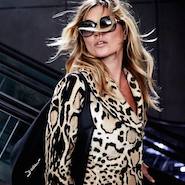
 Gucci campaign image for its Jackie bag featuring Kate Moss
Gucci campaign image for its Jackie bag featuring Kate Moss